Malfunctioning lithium-ion batteries in the increasingly popular form of transportation have been linked to numerous explosions, blazes, and deaths—and little is being done to reduce the danger
By Stephanie Clifford
At 29, Lanesha Hayden finally had a home of her own. She’d saved for years so her family could afford their own rental, choosing a ground-floor apartment in a three-story building in the Queens borough of New York City. One August day in 2021, Hayden noticed a family moving into the building’s basement, which the landlord rented though it wasn’t a legal dwelling. Around 2 a.m. the next day, Hayden says she heard “a loud explosion.” She ran to her apartment door.
“I saw nothing but black smoke; it was dark,” Hayden says. “I immediately realized something was going on because the tenant who’d just moved in that day, who started the fire, was screaming in the basement, was saying ‘Fire! Fire! Fire!’” Hayden alerted her partner and two daughters, and rushed them outside. Barefoot, they watched as firefighters helped nine other people escape down a ladder.
Firefighters searched the basement, where the fire started, and found a 9-year-old boy, Remi Miguel Gomez-Hernandez, already dead. By midmorning, firefighters had pinpointed the fire’s source. A lithium-ion battery from an electric bike was charging when it burst into flames, setting a room on fire.
Hayden says she can’t get the idea of the little boy’s death out of her head: “My kids could have been that kid, so I feel for that family.” More than a year later, she’s still dealing with the aftermath: The fire left her family temporarily homeless and without any material items. “It was all gone,” she says. “We didn’t have no shoes; we didn’t have no coats; wintertime is coming, and we didn’t have no clothes or anything for the kids,” she says. “To this day, we’re still trying to pick up where we left off.”
It’s particularly hard for her to process the idea that all this destruction stemmed from an e-bike. “To lose something to an object, which probably could have been avoided, was very traumatizing,” she says.
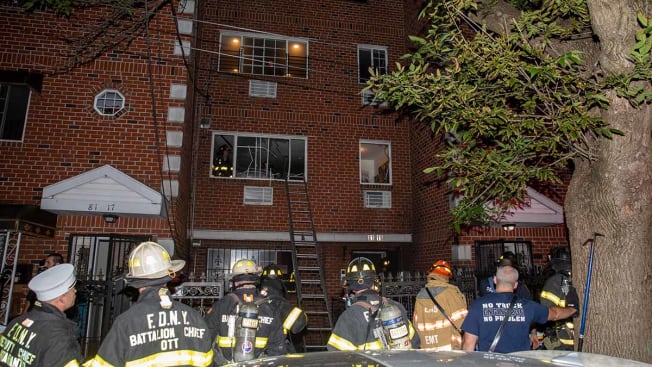
Firefighters responding to a September 2021 blaze at an apartment building in Queens, N.Y., where Lanesha Hayden lived. The fire was triggered by an e-bike battery and led to the death of her 9-year-old neighbor, Remi Miguel Gomez-Hernandez.
Photo: Brian Grogan
That Queens fire was one of 104 fires stemming from batteries for electric bikes or electric scooters, and one of four deaths attributed to those fires, in 2021 in New York City. A December 2021 fire from an electric bike battery in Manhattan public housing, for example, resulted in an adult dying and two children climbing down an exterior pipe from a fourth-floor apartment to escape. By the end of November 2022, the city’s fire department attributed 191 fires and six deaths to such batteries, including one in August that reportedly killed a 5-year-old and her father’s girlfriend.
Though the problem is seen in stark relief in New York City, given its close living quarters and electric bikes’ popularity there, similar reports come from around the world.
The London Fire Brigade says it handled more than 70 fires caused by electric bike and electric scooter batteries in 2021. China, where e-bikes became popular far before they did in the U.S., tallied 10,000 electric bike fires from 2013 to 2017, with more than 200 deaths, according to an official 2018 release. In September, the U.S. Consumer Product Safety Commission released a report in which it identified six deaths from 2017 to 2021 related to fires stemming from e-mobility devices, including bikes, scooters, and hoverboards.
Specific data on the brands causing these fires isn’t available, but fire experts say they suspect that low-quality batteries from fringe players are often to blame.
Incidents across the U.S. make regular news: A Bend, Ore., garage fire sparked by an electric bike battery; a Utah retirement-community home fire from a charging electric bike; a Baltimore apartment-garage blaze from an electric bike with its motor on fire. Indeed, the president of the National Bicycle Dealers Association, Heather Mason, says that 10 percent of its members—bike shops—report having “some sort of thermal runaway in their store” from a battery.
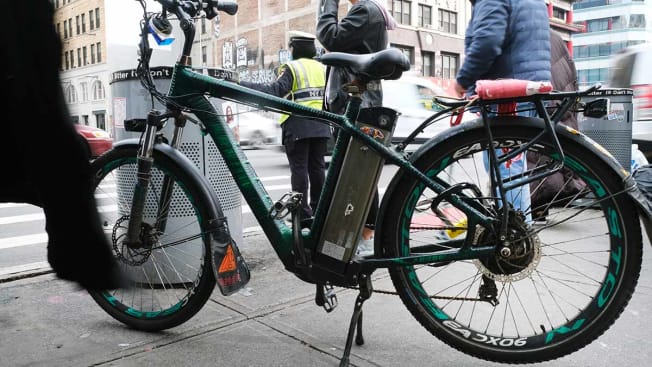
The use of e-bikes for commuting and food deliveries spiked during the pandemic.
Photo: Spencer Platt/Getty Images
Heralded as a potential fix to gas-powered cars and traffic-choked cities, electric bikes were slow to catch on in the U.S. until COVID-19 brought the niche transportation option into the mainstream. During lockdowns, people avoiding public transit and wanting outdoor time were willing to try the new technology. At the same time, usage of delivery apps increased—Uber Eats, DoorDash, and Grubhub all saw huge growth—adding more delivery workers, and more e-bikes, to the roads. Around 880,000 e-bikes were imported to the U.S. in 2021, almost double from 2020, according to estimates from the Light Electric Vehicle Association, an industry group.
When the lithium-ion batteries used in the bikes are poorly made, overused, or charged too long, though, they can cause fires. “It’s very violent, very fast, it’s hard to extinguish,” says Daniel E. Flynn, chief fire marshal at the Bureau of Fire Investigation in New York City’s fire department. “In the battery pack, when they do fail, they can shoot these cells as far as 60 feet, so multiple fires can be related to the battery failing,” he says.
But little is being done to address the danger.
That’s in part because e-bikes fall into something of a regulatory vacuum. Large agencies like those that govern workplace safety or highway safety generally don’t handle them, leaving oversight to the CPSC, an underfunded consumer-protection agency that has limited control over companies. And a little-noticed change to trade law enacted in 2016 means an increasing flood of poorly made, inexpensive bikes, which are not subject to tariffs and are almost entirely uninspected, are arriving in the U.S., “unsafe, untaxed: it’s not what anybody signed up for,” says Rep. Earl Blumenauer, D-Ore.
None of the companies that make, sell, use, or expect their workers to use these products seem able, or in many cases willing, to solve the problem industrywide. Amazon and other online marketplaces, for example, should do more to protect consumers from potentially dangerous electric bikes sold on their sites, regulators say. Food-delivery workers are independent contractors, left to fend for themselves when it comes to safety. Established e-bike manufacturers maintain that their vehicles aren’t the issue, so fixing the problem is not their role.
Meanwhile, irresponsible companies continue to sell electric bikes with potentially dangerous batteries—with little legal risk.
“I’ve been in this business for a long time: I started in a bike shop in 1957, I went to work for a bicycle company in 1966, so I’ve been around a while,” says Jay Townley, founding partner at Human Powered Solutions, a micromobility consulting firm. “I’m embarrassed by what I have found is the absolute lack of the industry concern about doing the right thing here. And I mean, embarrassed.”
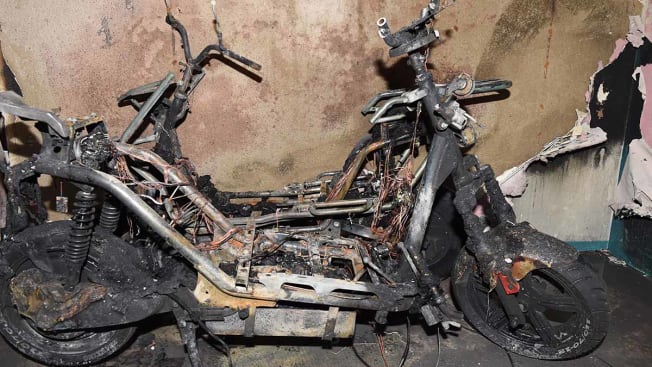
A January 2022 fire in the Bronx borough of New York City was caused by the battery in an electric scooter.
Source: FDNY
The Problem With Cheap Batteries
In 2007, Don DiCostanzo lived at the top of a hill in his seaside California town, a location that was lovely on the way to the beach—downhill—but not so fun on the way back. DiCostanzo “ended up hearing about electric bikes, and thought, ‘Well, that might solve my problem,’” he says. Electric bikes weren’t huge in 2007, but they’d been around for some time. As far back as 1895, an inventor named Ogden Bolton Jr. patented an “electrical bicycle,” and in the early 1990s, the Dolphin Electric Bike came on the market. By the early 2000s, e-bikes had a small but enthusiastic U.S. customer base.
DiCostanzo ordered an “ugly, clunky bike, but it got me up the hill,” he says. DiCostanzo, who owned a business selling car-wash chemicals and systems to auto dealerships, thought he might be on to his next business idea. He bought six more electric bikes, then opened an e-bike shop, then got frustrated with the quality of the suppliers. So he sold the car-wash business and started Pedego, which manufactures, sells, and rents electric bikes in bright colors with zippy profiles. He knew how popular e-bikes were in China, and thought it was only a matter of time before they became popular in the States.
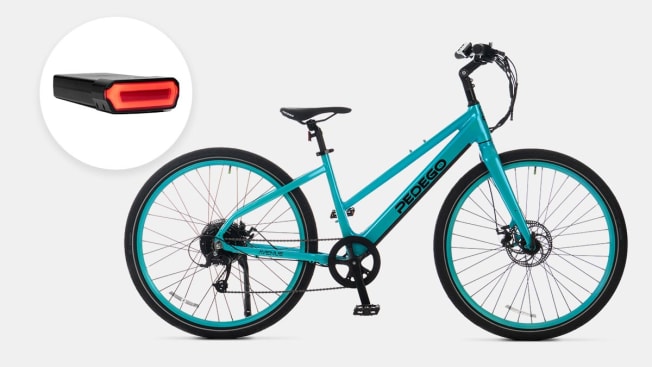
The California e-bike company Pedego switched to a new supplier and battery (inset photo) after it received reports of batteries catching on fire.
Photo: courtesy of Pedego
In choosing battery packs for the electric bikes, DiCostanzo knew he’d use lithium-ion batteries, which are used in modern technologies from phones to Teslas. They’re light, charge quickly, have good power for their weight, and are energy-efficient. The batteries in, say, cell phones are quite small; the battery packs get bigger and more complex as more energy is required. In an e-bike, the batteries are part of a sophisticated setup, housed inside a battery pack and managed by a system that protects cells from damage and monitors and adjusts charge level, temperature, and other factors. That said, take an e-bike battery pack apart (well, don’t, but watch a YouTube video of someone doing it), and it resembles a few dozen double batteries strapped together: deceptively simple-looking.
DiCostanzo, used to negotiating deals on chemicals, took the same approach with the lithium-ion batteries. “We sourced from a battery company that claimed to be reputable,” he says, and “we bought batteries for, say, $400 or $500 that maybe we could’ve paid $500 or $600 and had a quality one, but we didn’t know any better.”
In 2015, DiCostanzo learned his lesson the hard way. Pedego received six reports of the batteries catching fire; no injuries were reported. The company recalled 5,000 battery packs. Pedego found, he says, that its battery-pack supplier was not using a clean room to manufacture. A delicate membrane separates the anode and cathode on each battery, and DiCostanzo learned that “if you get just a speck of dust on that membrane during manufacturing, two or three years down the road, it can begin to corrode and cause that battery to catch fire,” he says, and “when one cell goes off, it starts igniting all the cells next to it, and it creates a fire that you can’t put out.”
The extra certainty of a brand name—unnecessary, perhaps, for, say, a handlebar grip—turned out to be critical. And the cost? Well worth it, he says. Now, he buys solely from Samsung and Panasonic, and has had no issues since.
Sales for DiCostanzo and e-bikes in general increased slowly in the following years—and then COVID-19 hit, providing an industrywide boost. With the increase in popularity, though, came more reports of lithium-ion battery fires. DiCostanzo says it was immediately clear to him what was happening. “Batteries can be made well, and they can be made cheaply and poorly,” he says.
The solution, then, seemed obvious: Require good-quality batteries, battery packs, and chargers, and keep the bad ones out of the market.
It wasn’t that simple.
A Regulatory Black Hole
An electric bike has both pedals and an electric motor. If that bike goes above 20 mph without the help of the rider pedaling, it’s considered a motorcycle and regulated by the National Highway Traffic Safety Administration. If it were used at a workplace, like a forklift is, jurisdiction would go to the Occupational Safety and Health Administration.
Instead, oversight of e-bikes falls to a defanged, underfunded agency with little power and far too much to do: the CPSC, which oversees 15,000 product categories, from baby bouncer chairs to butterfly nets. Its budget of $139 million is just a bit higher than that of the Energy Information Administration, which provides energy statistics. To put that in context in the corporate world, the agency’s entire budget is $73 million less than the Amazon CEO’s compensation last year.
Under the CPSC regulation, an electric bike is described as having “fully operable pedals,” an electric motor of 750 watts or less, and a top speed under 20 mph when it’s solely motor-powered.
Beyond those speed and power definitions, what specific requirements does the CPSC have for electric bikes?
There are none.
Zero.
The agency has published pages and pages about bicycle requirements, which it made mandatory in 1978, from the color of reflectors to handlebar stem insertion marks. Electric bikes must adhere to these.
But as for the safety or manufacturing practices of e-bike batteries, chargers, and electrical systems? Not a word.
The city’s fire department has been pushing the CPSC to regulate electric bikes. “The most equitable solution would be for manufacturers to design their devices to be safer rather than simply relying on consumers and delivery workers to bear the burden of mitigating risk,” Laura Kavanagh, the FDNY commissioner, wrote to the CPSC in August. New York City mayor Eric Adams has joined in that push.
The CPSC says it is aware of the issue. “It’s definitely a problem, and one that we’ve been tracking,” Alexander Hoehn-Saric, chair of the agency, told CR.
Yet despite its broad mandate, the CPSC, by design, has limited power. It was created in 1972; within a decade, the Reagan administration tried to eliminate the agency. A congressional compromise led to a new law: In most circumstances, the agency could no longer require industry to adhere to safety standards. Instead, it first had to defer to voluntary standards that are often heavily influenced by businesses themselves, only issuing a mandatory regulation—like the ones for bicycles—if “the current voluntary standard does not adequately reduce the risk” or “there is not likely to be substantial compliance,” as the CPSC put it in a recent presentation.
Even some at the CPSC itself have admitted the agency is outgunned, with the CPSC’s former acting chairman Bob Adler calling its budget “woefully inadequate” in a March 2021 letter to the House Committee on Appropriations. Because of the CPSC’s small budget, he wrote, it had to make harmful trade-offs, like how its lawyers who removed dangerous products from the market couldn’t also punish the wrongdoers with financial penalties because of “scarce resources.”
In some cases, companies simply don’t respond to the CPSC’s efforts to pull them into line.
This summer, for instance, the CPSC warned about the risk of battery fires from an e-mobility vehicle, an electric unicycle. But the manufacturer, King Song Intell, a manufacturer in China, and the importer and retailer EWheels, based in Florida, “have refused to recall the product,” the CPSC said in its release.
Asked about that type of response, Hoehn-Saric says “it is more common than I’d like it to be.” He adds that the Commission has been issuing more warnings as a result. If companies refuse to recall products, the CPSC can sue, but this is time-consuming and often ineffective, he says, particularly when a foreign manufacturer is involved.
Hoehn-Saric also says that with the CPSC’s limited power, it needs businesses to be more involved, especially in the case of electric bikes, given that so many are manufactured abroad and sold via Amazon and other e-commerce giants. “The platforms need to take more responsibility,” he says.
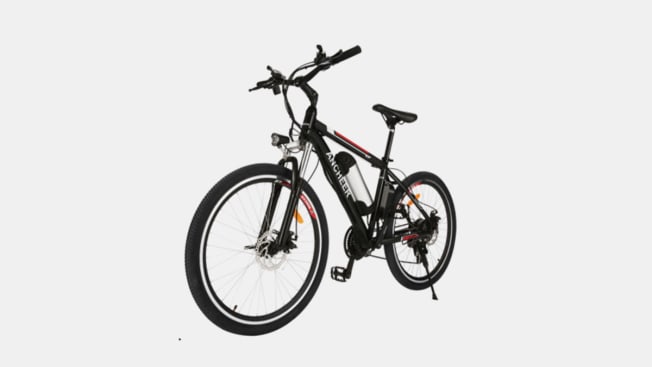
The Chinese e-bike manufacturer Ancheer recalled 22,000 of its electric bikes in October 2022 after reports of batteries catching fire and exploding.
Source: CPSC
Asked about this, an Amazon spokesperson says “we continuously monitor the products sold in our store for product safety concerns and when appropriate, remove a product from the store, communicate with sellers, manufacturers, and government agencies for additional information, or take other actions."
There are, though, examples where the CPSC deems something dangerous, acts quickly and effectively, and gets manufacturers to comply. In October, it announced that e-bike maker Ancheer was recalling 22,000 electric bikes, sold on Amazon, Walmart, Overstock, and some other online sites, after it had received six reports of “fires, explosions, or sparks” from the bikes’ batteries.
And soon after Christmas in 2015, following a spate of hoverboard fires stemming from lithium-ion batteries, the agency sent a letter urging all hoverboard makers to meet certain product standards, warning that if they didn’t, their products could be detained or seized at ports or recalled. That approach did the trick, the CPSC later reported.
The CPSC remains well aware of the danger of lithium-ion battery fires like that. In 2018, it reported it knew of 25,000 incidents of high-energy batteries (like lithium-ion and lithium polymer) overheating or creating fire hazards over a five-year period from 2012 to 2017.
Asked about criticism that the CPSC is not acting fast enough, Hoehn-Saric said that it would “welcome those discussions” with industry or other stakeholders.
Some are watching the CPSC with increasing frustration. “Government is not paying as much attention as it should, and inevitably there’s going to be some tragedy or several tragedies,” says Ed Benjamin, founder and chair of the Light Electric Vehicle Association. “And it’s a damn shame that that has to occur before enough attention comes to bear.”
Lacking Standards
Chicago’s Iroquois Theater opened to great fanfare in November 1903, with its grand façade, Ionic columns, and “absolutely fireproof” design, it said in its program for Dec. 30, 1903. That afternoon, a holiday audience of largely women and children filled its more than 1,700 seats and standing-room areas.
When a stage light ignited fabric onstage, though, a tragedy that would change the American approach to public safety unfolded. Stagehands aimed a supposed fire extinguisher at the flames, but it didn’t do a thing. Sets caught fire. Exits were blocked. The audience stampeded. And more than 600 people died.
Blame spread, from the architect who’d refused “Exit” signs, to the fire inspectors who’d allegedly overlooked code violations. Meanwhile, William H. Merrill, who’d first worked in Chicago inspecting lighting installations at the city’s 1893 World’s Fair, focused on the fire extinguisher. As he later described it, “a man put ten cents worth of baking soda in a five-cent tin tube. He sold it for three dollars as a fire extinguisher. . . . Lives were sacrificed that a man might make a profit of two dollars.”
Several years earlier, Merrill had started Underwriters Laboratories as an outgrowth of his World’s Fair work, testing products and issuing directories of products deemed trustworthy. With the Iroqouis fire, he realized consumers needed an easier way to sort safe from unsafe, and created the UL label for consumers to look for as they bought items like fire extinguishers, hoses, and wiring.
Today, UL Solutions—the branch of UL that develops standards, and one of several such organizations in the U.S.—has developed more than 1,500 standards, from mercantile burglar alarm systems to industrial trucks. In 2015, when several fires from lithium-ion batteries in hoverboards were reported, it quickly developed standards to cover those products, which the CPSC successfully urged manufacturers to adopt.
Given the similarity between the batteries in hoverboards and electric bikes, Ibrahim Jilani, global director of consumer technology at UL Solutions, was certain that e-bikes would soon have fires, too. “We tried to raise the awareness for the last five years, six years,” he says, that “we’re going to expect this to happen again.”
In 2020, UL Solutions introduced a standard for electric bikes. UL certification is expensive and time-consuming, but given the potential dangers, Jilani expected strong interest from companies—but so far has received little. “They feel like there’s no government regulation,” he says. Some companies are willing to talk with UL, he says, “but they are reluctant to take it further.”
As Townley, of Human Powered Solutions, describes the industry reaction to the UL standard: “They ignored it, and now they will not touch it.”
So far, only 13 companies have certified to the standard. One of them is Panasonic, where Steve Zaroukian, executive director at Panasonic Automotive Systems, oversees the making of batteries for electric bikes. Zaroukian says he wonders why more companies haven’t joined in. “Am I surprised? Yeah,” he says. “The industry itself could embrace it better.”
Mason, of the National Bicycle Dealers Association, recently recommended that bicycle retailers ask suppliers to certify to the UL standard. “Our retailer members applauded us. The bicycle industry did not,” she says. “I basically had suppliers that I have had, historically, a hard time even getting a conversation with, reaching out to me for appointments” to defend their decisions not to use the UL standard, she says, arguing that it was too expensive.
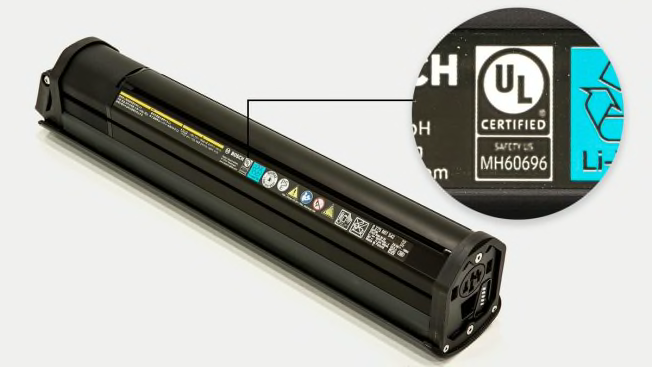
A UL-certified electric bike battery.
Photo: John Powers/Consumer Reports
UL’s Jilani said the price for electric bike UL certification is around $25,000, though if components, like batteries or electric motors, also need to be UL-certified, this could increase the price. But he also says that is a one-time expense that doesn’t add much to an e-bike’s total cost; for example, for a manufacturer that produces 1,000 e-bikes, UL safety certification would add only $2.50 to each bike.
And if money is the central concern, some industry experts say manufacturers can use other certified third-party labs instead.
Smaller e-bike makers argue that while big players can afford certification, they can’t. “I think it’s an attempt by the bigger companies to try to put the smaller companies out of business, because it’s cost-prohibitive for smaller companies,” says Pedego’s DiCostanzo.
Of UL’s standard, he says, “It makes a lot of sense. And most of our bikes are now built to meet that spec. We just haven’t gone to the level to test to it because we’re confident in the product without having a separate, certified seal of approval.”
For the CPSC to supplant the current, voluntary UL standard with a mandatory standard, it would need to show either that the voluntary standard does not adequately reduce the risk of injury, or that businesses aren’t likely to adopt the standard widely enough to protect consumers.
Asked about this, CPSC chair Hoehn-Saric was noncommittal. “As we’re gathering data from these incidents, we’re looking at these issues you’ve raised to see whether or not there’s additional steps that we need to take,” he says.
The 'Amazon Loophole'
Without regulatory action or a widely adopted industry standard enforced by the CPSC, it’s left to manufacturers to decide which batteries to use and which safety checks to perform.
For a high-end electric bike, retailing at several thousand dollars, manufacturers may choose expensive batteries, adhere to industry performance standards, and do extensive testing. But type “e-bike” into Amazon and you’ll get dozens of results, some as cheap as $400.
That math simply can’t work, says Oscar Morgan of scooter brand Bo Mobility, which will debut a high-tech, safety-focused electric scooter for about $2,400 this spring. “The cost of our battery pack, to us, is more than the entire cost of scooters that I’ve seen,” he says. When manufacturers work “on a very compressed budget, you really can’t afford to pay for all of the checks and balances, all of the quality control, and all of the things like traceability that ensure that your pack is safe,” he says.
Adding to the problem, an often overlooked change to a trade law in 2016 means that any item under $800 shipped from overseas to a consumer is not taxed and is almost never inspected, opening a floodgate, says Blumenauer, the Oregon representative, for cheap, dubious products—including electric bikes—to come into the U.S.
Officially called “de minimis,” and now unofficially called the “Amazon loophole,” the original idea of a low-value limit was that supercheap items could be imported without customs duties or taxes, to save the government hassle. Importers of products under that limit also don’t need to provide some basic information about those items, which could be used by border patrol in safety screening.
The initial limit, in 1938, was $1, rising to $200 in the 1990s. It stayed there until a 2016 bill raised it to $800. That $800 limit is vastly out of range with other countries’ de minimis limits: Mexico’s is about $50 in U.S. dollars, Canada’s is about $15, and China’s is $8.
And that high cutoff has led to a huge increase in cheap imports to the U.S. The amount of de minimis shipments has more than tripled since 2016, the year the limit was raised. In 2021, the figure grew to $771 million, up more than 21 percent from the prior year, according to figures from Customs and Border Protection, and it’s on track to far outpace that growth rate this year.
“It was never intended to be a gusher for consumer products coming into the United States, undercutting American production,” Blumenauer says. “What this means in the case of e-bikes is that there are a lot of $799 bikes that don’t meet quality standards; there may be safety issues,” he says.
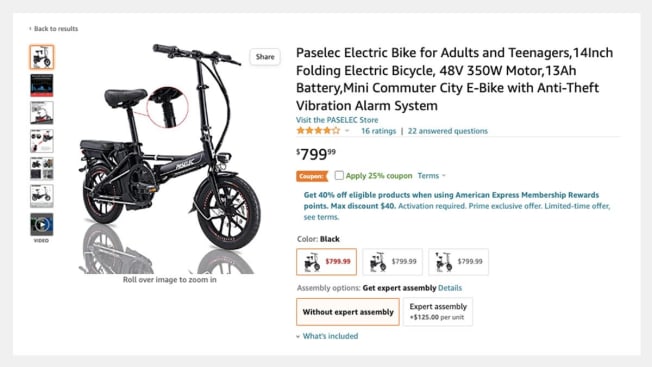
Many e-bikes sold on Amazon are listed below $800. Products priced below that threshold don’t have to pay import taxes and are less likely to be inspected.
Source: Amazon
Ancheer, the maker of the electric bikes recalled in October, sells all of its bikes under $800, for instance, and its website has a “Duty Free” banner at the top of it. Amazon lists Ancheer’s manufacturer as being Tianjin Gamma Electric Technology. A spin through Amazon in October found any number of competing e-bikes just under the de minimis limit: a $799.99 Lectric brand folding e-bike from Fuji-Ta of Tianjin; a $799.99 Heybike brand race e-bike (not to be confused, or perhaps meant to be confused, with Haibike, a well-known brand based in Germany); and a $799.99 folding e-bike from Euy Bikes, whose site boasted “free shipping and free tax.”
E-bike companies selling on the U.S. site, Amazon says, must submit paperwork showing they have certified to UL 2849, the standard for the batteries and other electronics in e-bikes. However, when CR performed a spot check of a dozen manufacturers listed at the top of Amazon’s results for electric bikes under $800, only one provided copies of UL 2849 certification, none were listed in UL’s database, and none of the manufacturers that had websites mentioned such certification on their sites. (Two of the companies had no obvious website nor e-mail address, so they could not be reached.)
While Customs and Border Protection technically has the power to examine the packages coming in under de minimis, it’s logistically impossible given the volume. Adler, the former acting chairman of the CPSC, says that agency has been similarly overwhelmed.
In January 2022, Blumenauer introduced legislation to lower that limit for all imports. However, lobbyists for companies that sell or ship through Amazon and FedEx, among others, opposed it, he says. They “make the argument that this is low-cost for consumers, and it’s economic activity for them. I get it,” he says. But “it shouldn’t be profitable at the expense of the American consumer and workers overseas,” he says, calling it “a terrible price” to pay.
Though his legislation didn’t pass, he’s hopeful he can revive it. When he explains it to people, “they can’t believe that we have a flood of products that come into this country untaxed, uninspected,” he says.
'A Worker Safety Issue'
Without movement on that, though, and without help from regulators or businesses, the job of evaluating electric bike safety is left to consumers. That leaves the market bifurcated in a disturbing way. Rich consumers may be able to buy an expensive bike, perhaps certified to the UL standard, and charge it and care for it according to the manufacturer’s suggestions: a safe bet.
“Lithium-ion batteries are not inherently dangerous, if they’re properly designed, if they’re properly manufactured,” says Mike Fritz, founding partner and chief technology officer of Human Powered Solutions. “If it’s a quality pack, the likelihood that it’s going to fail catastrophically is very, very small, and it’s almost zero if the pack is well-maintained.”
Poorer, more vulnerable consumers—particularly the delivery workers who use these electric bikes for their jobs—don’t have that luxury. They may not be able to afford high-end bikes, and often buy secondhand batteries, according to a delivery workers’ group and fire investigators. They may refurbish the bike batteries themselves, or use uncertified mechanics. With no standards in place, “we don’t know what to comply with,” says Hildalyn Colón Hernández, director of policy and strategic partnerships at Los Deliveristas Unidos, a group representing New York City’s 65,000 app-based delivery workers.
These workers are also under pressure to use the batteries far more heavily than the batteries were designed for, and in rough conditions like rain, which affects battery safety. Because of their long hours, workers often carry a spare battery and switch midway through their shifts, Hernández says. Though safety experts say only the manufacturer-supplied battery and charger should be used with an electric bike, this simply isn’t always feasible for delivery workers.
While delivery workers are worried about safety, they’re also concerned that regulations or requirements in the electric bike area could increase their costs. They make, on average, $12.21 per hour including tips, or about $24,000 a year based on a standard 40-hour workweek. (Very few delivery workers work a 40-hour week; most do 12-hour shifts, six days a week, Hernández says.)
They are classified as “independent contractors” rather than employees, part of how huge companies like Uber and Grubhub keep their costs low and their profits up, so the workers don’t get benefits, sick pay, or vacation pay, and must cover their own equipment (and often aren’t eligible for workers’ compensation even for work-related injuries). “This is a worker safety issue,” Hernández says.
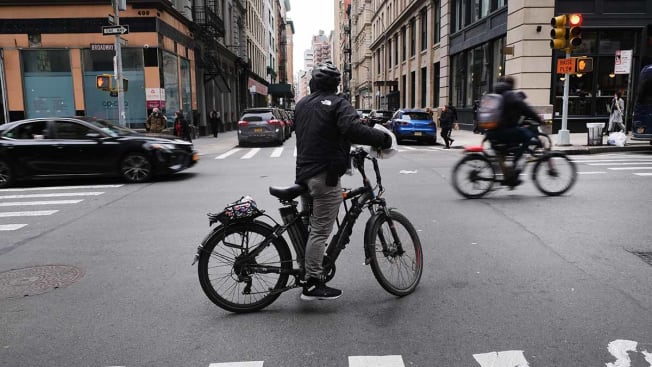
E-bikes used by food delivery workers are common on New York City streets.
Photo: Spencer Platt/Getty Images
OSHA, which regulates workplace safety, did not answer a question from CR about why these electric bikes were not considered workplace vehicles, instead pointing to regulations around lithium-ion battery use at workplaces.
Freddi Goldstein, an Uber spokeswoman, didn’t answer questions CR asked about subsidizing safer, if more expensive, bikes, for its Uber Eats delivery workers, or raising wages so its workers can afford better batteries. Instead, she says that Uber is working on educational materials and charging stations. Grubhub had a similar response, saying “spreading public awareness” about safety and focusing on “better charging infrastructure” were its priorities.
If investigators could pinpoint the precise brands linked with the fires, they could at least warn consumers about those, but even that is tricky. “It’s really difficult in many of these fires to gather that information because people are buying them secondhand, buying it online assuming they’re getting a good product and they may not be buying it from the manufacturer, people buying it from Craigslist not knowing what these batteries have been subjected to prior to the purchase,” says the FDNY’s Flynn.
All that may give manufacturers, retailers, and websites cover for not adopting safety measures. “The rationale there is that the higher-end bike guys are basically saying, ‘It’s not my problem. It’s not my bikes that are catching fire in New York. It’s that cheap crap they’re importing from China. It’s not my bike. Why should I have to worry about it?’ Well, it’s an e-bike. We’re all gonna get painted with the same brush regardless of the price tag of the bike,” says Fritz, at Human Powered Solutions.
But the consequences of this strategy are starting to land.
Insurers, for one, are starting to charge more for electric bikes. “Some insurance companies won’t even insure bicycle retailers who carry more than 50 percent of e-bikes in their store,” Mason says, or “your premium goes up and it makes it really hard for a retailer.”
AXA, the British insurer, said in August that in the prior two months it had covered almost half a million pounds in losses from lithium-battery fires, usually in residential buildings, giving examples of electric bike and electric scooter charging fires.
And insurers are going after manufacturers themselves. In October, State Farm sued Rad Power Bikes, a manufacturer based in Seattle, claiming one of its electric bikes “malfunctioned and failed catastrophically,” resulting in $250,000 worth of damage to a home and cars that State Farm insured. The suit is ongoing.
Beyond the financial repercussions, there could be reputational ones for e-bike makers, even the good actors. It’s “guilt by association to some extent,” Zaroukian of Panasonic says.
Echoes Fritz: “We’re afraid that this situation’s gonna color the whole industry, and generate the impression in the minds of consumers that they’re so dangerous, they’re just not worth it.”
Within the industry, there isn’t even consensus about whether these fires are the most pressing safety matter, with some worrying more about road safety, traffic laws, or electric bike speed issues.
Overall, electric bike enthusiasts worry that a promising product will be sidelined if companies don’t make a move.
“Fundamentally, this is a product that will help us get out of a serious environmental problem. But the industry, by not paying attention to this piece of the detail of this,” Townley says, is failing: “We are not willing, as an industry, to learn about the hazards associated with these lithium-ion batteries and doing something about it to mitigate it to a bare minimum.”
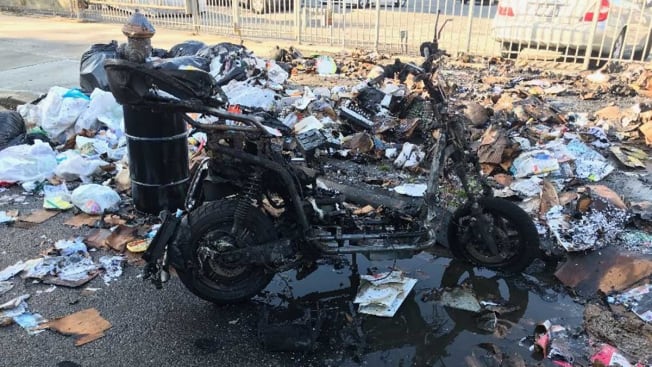
Remnants of an April 2022 fire in New York City triggered by the battery in an electric bike/scooter.
Source: FDNY
The (E-Bike) Path Forward
With New York among the first U.S. cities to register problems with electric bike batteries, it has also been at the forefront of some potential solutions—though there are no easy answers.
One city council bill would ban the sale or assembly of lithium-ion batteries made from used battery cells; another would require any lithium-ion battery sold in the city to be “listed and labeled” by a testing organization. The latter bill is supported by at least one delivery company, DoorDash, where a spokeswoman says “more needs to be done to address unsafe devices and batteries.” DoorDash says it is also partnering with Zoomo, an e-bike rental and sales company tailored to couriers, to offer its delivery workers a discount on Zoomo’s rental plans.
In October, the city unveiled another solution: kiosks where delivery workers can rest and charge their bike batteries.
The city’s fire department has banned e-mobility devices at its headquarters, trained firefighters on how to respond to lithium-ion battery fires, and is educating fire departments around the country about the risk. And in late November, the FDNY required landlords in the city to distribute a safety bulletin in residential buildings warning tenants about the potential dangers of charging electric bikes and electric scooters.
After several fires in public housing from e-bike and e-scooter batteries, the city’s housing authority floated the idea of banning the vehicles in those buildings. Los Deliveristas Unidos, the group representing delivery workers, pushed back, saying this was forcing poor people to choose between their housing and their means of making a living or commuting. The housing authority has not moved ahead with the rule, a spokeswoman says.
Nationally, UL continues to push companies to adopt its standard, and at least some manufacturers say they hope the CPSC makes that mandatory. And Blumenauer remains hopeful that he can get consumers passionate about changing the de minimis limit.
As for the rest of the companies and government entities involved, it would be a case of finger-pointing if they bothered to finger-point; instead, most are giving a giant shrug. For it’s not the “good” bike manufacturers’ problem, not really, and it’s not Amazon’s, or Uber’s, or Grubhub’s. It’s not NHTSA’s or the CBP’s, either, and the agency that is responsible, the CPSC, doesn’t have the resources it needs. Congress isn’t stepping up, either, to give any of the agencies the funding or authority required.
It’s not anyone’s problem—except for the everyday consumer.
As autumn went on in New York, more incidents piled up. Eight-year-old Stefanie Villa Torres died after an electric bike battery exploded in her Queens apartment. And close to 50 people were injured after an electric bike battery caught fire in a Midtown apartment where at least five bikes were stored; fire officials said they were investigating whether the apartment owner was illegally repairing the vehicles.
Lanesha Hayden, meanwhile, constantly worries that she smells smoke, she says, and if her daughters “hear any loud explosion or anything bang, anything that sounds out of the normal like loud noises or flashing lights that look like colors of fire, they get very scared.”
Then there’s the very real financial loss. “We had saved up to be independent and move on our own,” and now, “we’re sleeping on couches,” she says. “Coming from being on your own to having to go back to square one is not an easy thing.”
And she can’t understand why, given what happened to her, given what everyone seems to know can happen with electric bikes, no one is taking action.
“They’ve been speaking on it, but they haven’t done anything, and being a victim of something like this, it’s really something that needs to be fixed immediately,” Hayden says. “We don’t want to lose any more people. We don’t want any accidents or fires that we can’t control, or children dying, or anything of that nature. That’s not okay.”
Consumer Reports is an independent, nonprofit organization that works side by side with consumers to create a fairer, safer, and healthier world. CR does not endorse products or services, and does not accept advertising. Copyright © 2022, Consumer Reports, Inc.
